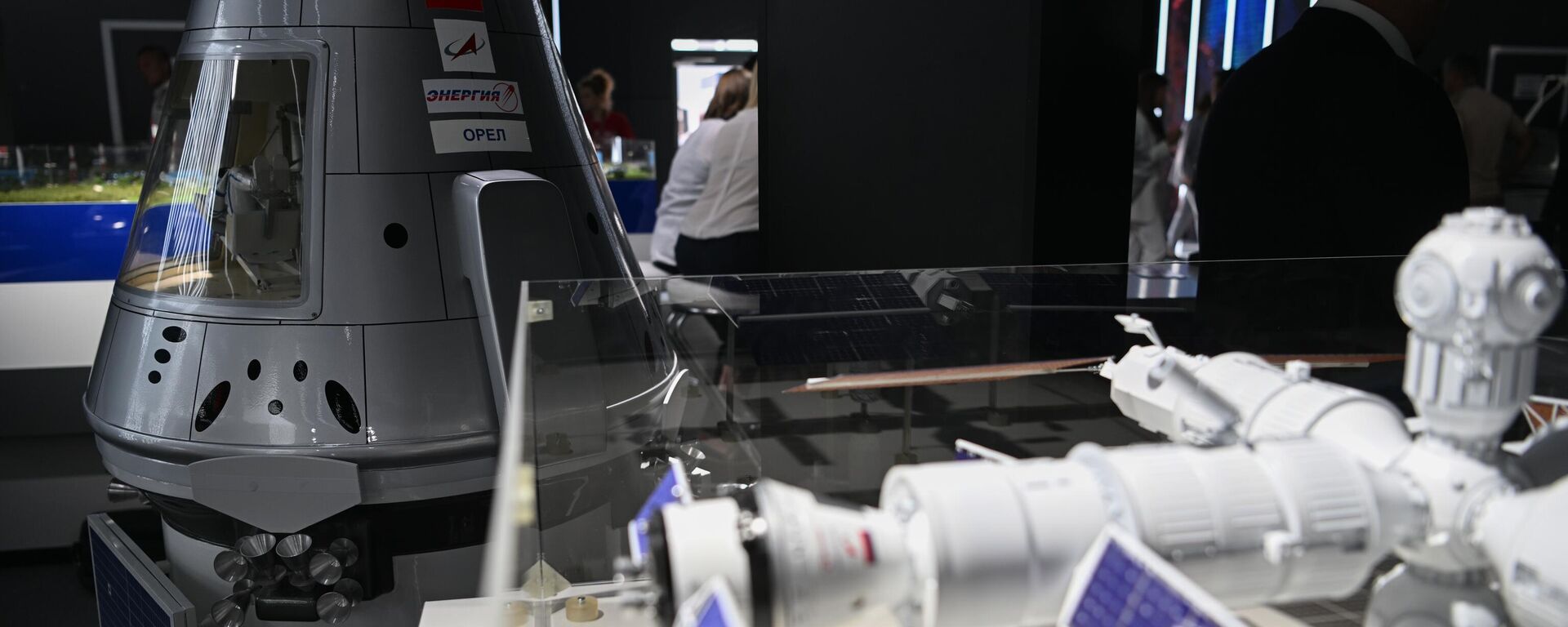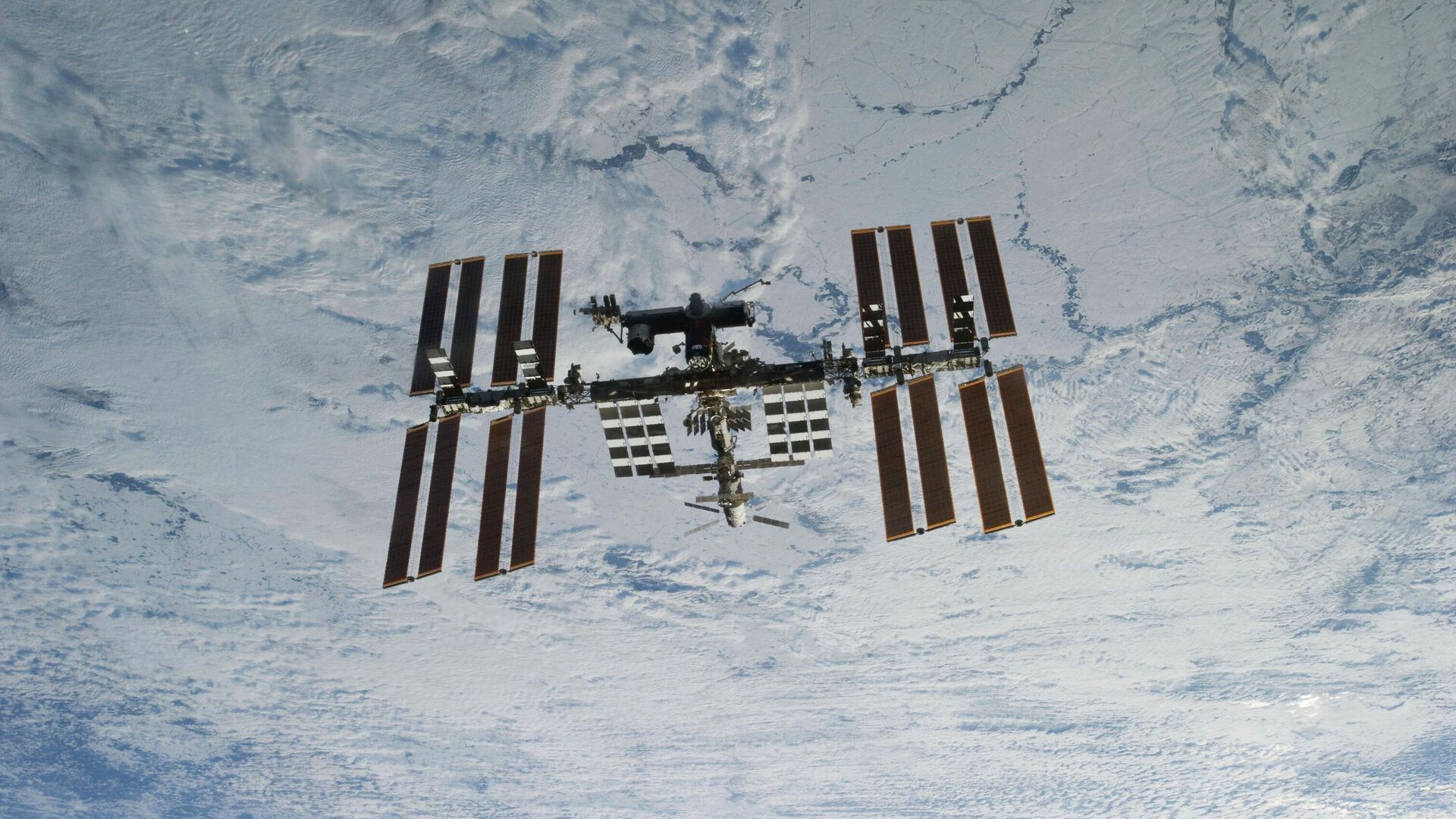https://sputnikglobe.com/20231120/roscosmos-celebrates-silver-anniversary-of-its-global-space-odyssey-at-iss-1115067076.html
Roscosmos Celebrates Silver Anniversary of Its Global Space Odyssey at ISS
Roscosmos Celebrates Silver Anniversary of Its Global Space Odyssey at ISS
Sputnik International
The International Space Station, initiated with Russia's Zarya module launch in 1998, has seen significant contributions: 275 launches, 269 spacewalks, and 337 docking operations. The ISS has hosted 273 astronauts from 21 countries, marking a monumental achievement in international space collaboration and research.
2023-11-20T12:00+0000
2023-11-20T12:00+0000
2023-11-20T12:01+0000
world
science & tech
newsfeed
yuri malenchenko
fyodor yurchikhin
americans
russia
japan
canada
european space agency (esa)
https://cdn1.img.sputnikglobe.com/img/07e6/08/0d/1099548951_0:176:3017:1873_1920x0_80_0_0_3d6050b3288236c1a7659ff1f30f70e3.jpg
Roscosmos recently released data detailing the number of space missions and extravehicular activities conducted by astronauts and cosmonauts during the International Space Station's quarter-century history. On November 20, 1998, a Proton-K rocket from the Baikonur Cosmodrome successfully propelled the Russian-made Zarya functional cargo block (FCB) into space, marking the inception of the International Space Station (ISS). A few weeks later, on December 7, this module was joined in orbit by the American Unity node module, transported by the Endeavor space shuttle during the STS-88 mission.ISS Segments, Spacecraft, and Crew MembersAccording to the Roscosmos report, Russia’s segment of the ISS consists of six modules: the functional cargo block Zarya, the service module Zvezda, the Poisk and Rassvet small research modules, the Nauka multipurpose module, and the Prichal node module. The US part of the facility includes a variety of modules: Unity, Harmony, and Tranquility as node modules; Destiny and Columbus for laboratory work; Quest as the airlock; Kibo for experimental purposes; Cupola for observations; Leonardo as a versatile module; and BEAM, an inflatable unit.Moreover, the publication stated that 273 individuals from 21 countries have visited the station: 59 Russians, 165 Americans, 11 Japanese, 9 Canadians, 5 Italians, 4 French and Germans each, 2 citizens from Saudi Arabia and the United Arab Emirates each; and 1 citizen each from Spain, South Africa, Belgium, the Netherlands, Brazil, Sweden, Malaysia, South Korea, Denmark, Kazakhstan, United Kingdom, and Israel.It is noted that the Russians who flew to the ISS most were Yuri Malenchenko, Fyodor Yurchikhin, and Oleg Kononenko - five times each. The record holders for flight duration were Russians Sergey Prokopyev and Dmitry Petelin and American Francisco Rubio; they spent 370 days, 21 hours, 22 minutes, and 16 seconds on board (from launch on September 21, 2022, to landing on September 27, 2023).Since November 2, 2000, long-term expedition crews have continuously staffed the International Space Station. Presently, the 70th long-term expedition is underway, comprising cosmonauts Oleg Kononenko, Nikolai Chub, and Konstantin Borisov from Roscosmos State Corporation, NASA astronauts Jasmine Moghbeli and Laural O'Hara, ESA (European Space Agency) astronaut Andreas Mogensen, and JAXA (Japan Aerospace Exploration Agency) astronaut Satoshi Furukawa. This diverse team conducts scientific research and experiments aboard the station.Construction and OperationsRoscosmos reported 275 launches during the ISS's construction and operational phases. This number includes 115 human-crewed missions, with Russia's Soyuz contributing 68 flights, America's shuttles providing 37, and the Crew Dragon from the US accounting for 10.Furthermore, five crewless station trips have been completed: Russia’s Soyuz (2), American Crew Dragon (1), and Starliner (2).Over the past 25 years, the ISS has received 152 cargo ships: 88 from the Russian Progress, 30 from the American Dragon, 20 from the American Cygnus, 5 European ATVs, and 9 Japanese HTVs. Three of Russia’s station modules, Zarya, Zvezda, and Nauka, were self-transported to the ISS.Space OperationsAstronauts and cosmonauts have embarked on 269 spacewalks from the ISS, 198 using American spacesuits and 71 using Russian gear. The station's external operations have involved a diverse crew comprising 38 Russians, 97 Americans, 4 each from Canada, Japan, and Germany, 2 from France and Italy, and one from Sweden, the United Kingdom, and the UAE.Michael Lopez-Alegria, Peggy Whitson, Robert Behnken, Stephen Bowen, and Christopher Cassidy are prominent American astronauts who each undertook 10 spacewalks. Lopez-Alegria holds the record for the longest duration spent on such missions, accumulating 67 hours and 40 minutes. The record for the lengthiest single spacewalk was set by James Voss and Susan Helms on March 11, 2001, with a duration of 8 hours and 56 minutes, performed in US spacesuits.Docking and Orbital CorrectionsThe ISS has been the site of 337 docking and re-docking operations, 190 and 147 of which were performed in its Russian and American sections, respectively. Additionally, the station's orbit has undergone 350 corrections, involving 196 interventions by Russia’s Progress ships, 53 by American shuttles, 40 by the Russian Zvezda service module, 39 by ATV crafts, 17 by the Russian Zarya functional cargo block, and 5 by the US' Cygnus ships.
https://sputnikglobe.com/20231027/full-scale-work-on-russian-orbital-station-must-start-in-2024---russias-roscosmos-ceo-1114527685.html
russia
japan
canada
Sputnik International
feedback@sputniknews.com
+74956456601
MIA „Rossiya Segodnya“
2023
Chimauchem Nwosu
https://cdn1.img.sputnikglobe.com/img/07e7/09/01/1113046371_0:99:1536:1635_100x100_80_0_0_9c5c627283eca931c39fe4852bbb301c.jpg
Chimauchem Nwosu
https://cdn1.img.sputnikglobe.com/img/07e7/09/01/1113046371_0:99:1536:1635_100x100_80_0_0_9c5c627283eca931c39fe4852bbb301c.jpg
News
en_EN
Sputnik International
feedback@sputniknews.com
+74956456601
MIA „Rossiya Segodnya“
Sputnik International
feedback@sputniknews.com
+74956456601
MIA „Rossiya Segodnya“
Chimauchem Nwosu
https://cdn1.img.sputnikglobe.com/img/07e7/09/01/1113046371_0:99:1536:1635_100x100_80_0_0_9c5c627283eca931c39fe4852bbb301c.jpg
international space station, iss, roscosmos, spacewalks, russian astronauts, russian cosmonauts, zarya module, space docking operations, iss missions, space missions, expedition crews, extravehicular activities, nasa astronauts, nasa cosmonauts.
international space station, iss, roscosmos, spacewalks, russian astronauts, russian cosmonauts, zarya module, space docking operations, iss missions, space missions, expedition crews, extravehicular activities, nasa astronauts, nasa cosmonauts.
Roscosmos Celebrates Silver Anniversary of Its Global Space Odyssey at ISS
12:00 GMT 20.11.2023 (Updated: 12:01 GMT 20.11.2023) The International Space Station, initiated with Russia's Zarya module launch in 1998, has seen significant contributions: 275 launches, 269 spacewalks, and 337 docking operations. The ISS has hosted 273 astronauts from 21 countries, marking a monumental achievement in international space collaboration and research.
Roscosmos
recently released data detailing the number of space missions and extravehicular activities conducted by astronauts and cosmonauts during the International Space Station's quarter-century history.
On November 20, 1998, a Proton-K rocket from the
Baikonur Cosmodrome successfully propelled the Russian-made Zarya functional cargo block (FCB) into space, marking the inception of the International Space Station (ISS). A few weeks later, on December 7, this module was joined in orbit by the American Unity node module, transported by the Endeavor space shuttle during the STS-88 mission.
ISS Segments, Spacecraft, and Crew Members
According to the
Roscosmos report, Russia’s segment of the ISS consists of six modules: the functional cargo block Zarya, the service module Zvezda, the Poisk and Rassvet small research modules, the Nauka multipurpose module, and the Prichal node module. The US part of the facility includes a variety of modules: Unity, Harmony, and Tranquility as node modules; Destiny and Columbus for laboratory work; Quest as the airlock; Kibo for experimental purposes; Cupola for observations; Leonardo as a versatile module; and BEAM, an inflatable unit.
Moreover, the publication stated that 273 individuals from 21 countries have visited the station: 59 Russians, 165 Americans, 11 Japanese, 9 Canadians, 5 Italians, 4 French and Germans each, 2 citizens from Saudi Arabia and the United Arab Emirates each; and 1 citizen each from Spain, South Africa, Belgium, the Netherlands, Brazil, Sweden, Malaysia, South Korea, Denmark, Kazakhstan, United Kingdom, and Israel.

27 October 2023, 12:39 GMT
It is noted that the Russians who flew to the ISS most were Yuri Malenchenko, Fyodor Yurchikhin, and Oleg Kononenko - five times each. The record holders for flight duration were Russians Sergey Prokopyev and Dmitry Petelin and American Francisco Rubio; they spent 370 days, 21 hours, 22 minutes, and 16 seconds on board (from launch on September 21, 2022, to landing on September 27, 2023).
Since November 2, 2000,
long-term expedition crews have continuously staffed the International Space Station. Presently, the 70th long-term expedition is underway, comprising cosmonauts Oleg Kononenko, Nikolai Chub, and Konstantin Borisov from Roscosmos State Corporation, NASA astronauts Jasmine Moghbeli and Laural O'Hara, ESA (European Space Agency) astronaut Andreas Mogensen, and JAXA (Japan Aerospace Exploration Agency) astronaut Satoshi Furukawa. This diverse team conducts scientific research and experiments aboard the station.
Construction and Operations
Roscosmos reported 275 launches during the ISS's construction and operational phases. This number includes 115 human-crewed missions, with Russia's Soyuz contributing 68 flights, America's shuttles providing 37, and the Crew Dragon from the US accounting for 10.
Furthermore, five crewless station trips have been completed: Russia’s Soyuz (2), American Crew Dragon (1), and Starliner (2).
Over the past 25 years, the ISS has received 152 cargo ships: 88 from the Russian Progress, 30 from the American Dragon, 20 from the American Cygnus, 5 European ATVs, and 9 Japanese HTVs. Three of Russia’s station modules, Zarya, Zvezda, and Nauka, were self-transported to the ISS.
Astronauts and cosmonauts have embarked on 269 spacewalks from the ISS, 198 using American spacesuits and 71 using Russian gear. The station's external operations have involved a diverse crew comprising 38 Russians, 97 Americans, 4 each from Canada, Japan, and Germany, 2 from France and Italy, and one from Sweden, the United Kingdom, and the UAE.
Michael Lopez-Alegria, Peggy Whitson, Robert Behnken, Stephen Bowen, and Christopher Cassidy are prominent American astronauts who each undertook 10 spacewalks. Lopez-Alegria holds the record for the longest duration spent on such missions, accumulating 67 hours and 40 minutes. The record for the lengthiest single spacewalk was set by James Voss and Susan Helms on March 11, 2001, with a duration of 8 hours and 56 minutes, performed in US spacesuits.
Docking and Orbital Corrections
The ISS has been the site of 337 docking and re-docking operations, 190 and 147 of which were performed in its Russian and American sections, respectively. Additionally, the station's orbit has undergone 350 corrections, involving 196 interventions by Russia’s Progress ships, 53 by American shuttles, 40 by the Russian Zvezda service module, 39 by ATV crafts, 17 by the Russian Zarya functional cargo block, and 5 by the US' Cygnus ships.




